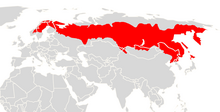Gray bank vole
| Gray bank vole | ||||||||||||
|---|---|---|---|---|---|---|---|---|---|---|---|---|

Gray bank vole ( Myodes rufocanus ) |
||||||||||||
| Systematics | ||||||||||||
|
||||||||||||
| Scientific name | ||||||||||||
| Myodes rufocanus | ||||||||||||
| Sundevall , 1846 |
The gray bank vole ( Myodes rufocanus ) is a type of voles from the bank vole genus .
description
The gray bank vole has a characteristic drawing with a red-brown back, blue-gray side stripes and cheeks and a light gray belly. With a head body length of 90 to 135 millimeters, it is one of the relatively large voles. The tail is 25 to 45 millimeters long and takes up about 25% of the total length. The weight of the mouse is between 20 and 50 grams.
distribution
This species lives in Scandinavia north of the 65th parallel and in the Russian taiga .
Way of life
The gray bank vole is a skilled climber and swimmer. She doesn't like digging in the ground, preferring to use the existing holes. In contrast, in winter it digs long systems of passages in the snow above the surface of the earth. The spherical nest lies directly above the ground and is padded with grass, twigs, birch bark and stalks.
The summer nests are usually under roots or stones and sometimes in trees. The gray bank vole prefers mountainous terrain but can also be found near the coast in the far north. It is mainly a crepuscular animal, but in summer you can sometimes see it in the middle of the day.
The diet consists mainly of leaves and herbs. She continues to eat berries and in winter also bark and twigs. The Swedish zoologist Kai Curry-Lindahl states that she can also eat animal food.
Reproduction
Each female has a territory and mates with several males. The mating season extends from May to September. 2 to 10 (usually 5 to 6) young animals are born per litter. Every year 3 to 4 litters are possible.
swell
-
Article " gråsiding " from Swedish Wikipedia (October 1, 2006) with the following sources:
- Birger Jensen: North däggdjur. Norstedt, Stockholm 1994, ISBN 91-1-933262-9 .
- Kai Curry-Lindahl: Däggdjur, groddjur & kräldjur. Norstedt, Stockholm 1988, ISBN 91-1-864142-3 .
Web links
- Myodes rufocanus in the endangered Red List species the IUCN 2010. Posted by: Sheftel, B. & Henttonen, H., 2008. Retrieved on November 26, 2010.
